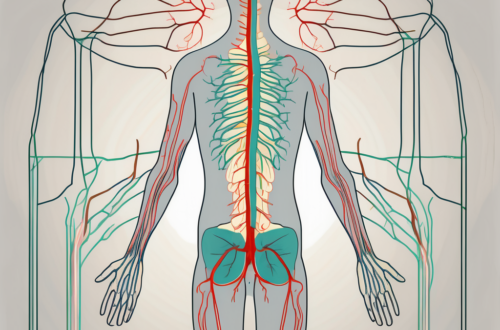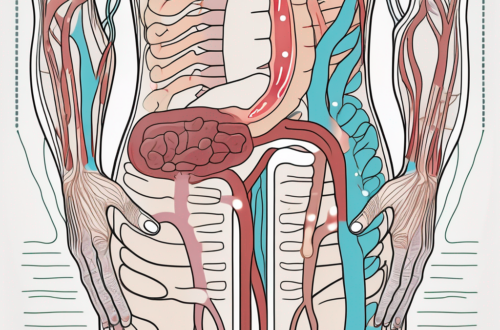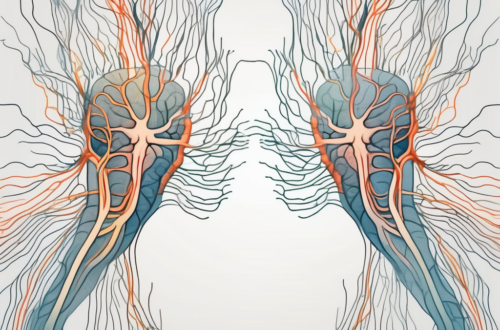The functioning of the human body is a complex and intricate system, with various components working together to maintain balance and regulate our bodily functions. One of the key players in this system is the vagus nerve, a crucial part of the autonomic nervous system responsible for regulating the balance between parasympathetic and sympathetic activation. In this article, we will explore the role of the vagus nerve and its influence on our overall well-being.
An Overview of the Nervous System
To understand the role of the vagus nerve, it is essential to have a basic understanding of the nervous system as a whole. The nervous system is a complex network of cells and fibers that transmit signals between different parts of the body. It plays a crucial role in coordinating and regulating bodily functions, allowing us to interact with our environment and respond to stimuli.
The nervous system is divided into two main parts: the central nervous system (CNS) and the peripheral nervous system (PNS). The CNS consists of the brain and the spinal cord, which are protected by the skull and the vertebral column, respectively. These vital organs serve as the command center of the body, receiving and processing information from the PNS and coordinating appropriate responses.
The PNS, on the other hand, includes all the nerves and ganglia outside of the CNS. It acts as a communication network, relaying sensory information from the body to the CNS and carrying motor commands from the CNS to the muscles and organs. The PNS can be further divided into the somatic nervous system and the autonomic nervous system.
The Central and Peripheral Nervous Systems
The central nervous system, consisting of the brain and spinal cord, is responsible for processing and integrating information received from the peripheral nervous system. The brain, a highly complex organ, is divided into different regions that specialize in various functions such as cognition, emotion, and sensory perception. It is composed of billions of neurons, the basic building blocks of the nervous system, which communicate with each other through electrical and chemical signals.
The spinal cord, on the other hand, serves as a pathway for signals traveling between the brain and the rest of the body. It is responsible for reflex actions, such as pulling your hand away from a hot surface without conscious thought. The spinal cord also plays a crucial role in coordinating voluntary movements and transmitting sensory information to the brain.
The Autonomic Nervous System
Within the peripheral nervous system, the autonomic nervous system (ANS) is responsible for the involuntary control of bodily functions. It regulates processes such as heart rate, digestion, respiration, and glandular secretion, allowing our bodies to maintain homeostasis. The ANS can be further divided into two branches: the sympathetic nervous system (SNS) and the parasympathetic nervous system (PNS).
The sympathetic nervous system is responsible for the body’s “fight or flight” response, preparing us for action in times of stress or danger. It increases heart rate, dilates blood vessels, and redirects blood flow to the muscles, enabling us to respond quickly to potential threats. On the other hand, the parasympathetic nervous system is responsible for the body’s “rest and digest” response, promoting relaxation and conserving energy. It slows heart rate, constricts blood vessels, and enhances digestion and nutrient absorption.
One of the key players in the autonomic nervous system is the vagus nerve, also known as the tenth cranial nerve. It is the longest cranial nerve in the body and plays a vital role in regulating various bodily functions. The vagus nerve is responsible for controlling heart rate, breathing, digestion, and even influencing mood and emotions. It acts as a bidirectional communication highway between the brain and the body, transmitting signals in both directions and playing a crucial role in maintaining homeostasis.
In conclusion, the nervous system is a complex and intricate network that allows us to interact with the world around us. From the central nervous system, which processes and integrates information, to the peripheral nervous system, which relays signals between the CNS and the rest of the body, every component plays a crucial role in maintaining our overall well-being. Understanding the nervous system and its various components, such as the autonomic nervous system and the vagus nerve, can provide valuable insights into how our bodies function and respond to different stimuli.
The Vagus Nerve Explained
Located within the Autonomic Nervous System (ANS) is the vagus nerve, the largest cranial nerve in the body. Stretching from the brainstem down to the abdomen, the vagus nerve is a vital link between the brain and various organs, including the heart, lungs, and digestive system.
The vagus nerve, also known as the tenth cranial nerve or CN X, is an incredibly intricate and fascinating part of the human body. Let’s dive deeper into the anatomy and functions of this remarkable nerve.
Anatomy of the Vagus Nerve
The vagus nerve is a complex network of fibers that emerges from the medulla oblongata, a region at the base of the brainstem. It extends down through the neck and chest, branching out to innervate various organs along its path. This intricate connection allows for constant bidirectional communication between the brain and the organs, ensuring that they function properly.
As the vagus nerve travels through the body, it forms multiple branches, each responsible for different functions. These branches innervate the heart, lungs, liver, spleen, stomach, intestines, and many other vital organs. This extensive network enables the vagus nerve to regulate and control a wide range of physiological processes.
Interestingly, the vagus nerve is not limited to the major organs. It also extends its reach to smaller structures, such as the larynx, pharynx, and even the muscles responsible for facial expressions. This extensive innervation highlights the far-reaching influence of the vagus nerve on various aspects of our bodily functions.
Functions of the Vagus Nerve
The vagus nerve plays a crucial role in maintaining overall physiological balance and well-being. It controls many essential functions, including heart rate, digestion, respiration, and immune response. This means that the vagus nerve is involved in both involuntary processes, such as heartbeats and digestion, as well as conscious actions, like breathing and swallowing.
One of the most remarkable aspects of the vagus nerve is its influence on the parasympathetic nervous system, which is responsible for the body’s rest and digest response. When activated, the vagus nerve helps reduce heart rate, relaxes blood vessels, and stimulates digestion. This calming effect is essential for maintaining a healthy balance in our bodies.
Beyond its role in regulating physiological functions, the vagus nerve also has an impact on cognitive and emotional processes. Research suggests that the vagus nerve is involved in memory formation and recall, mood regulation, and even social interactions. It is fascinating to think that this nerve, stretching from our brain to our gut, can influence our thoughts, emotions, and social behavior.
Furthermore, the vagus nerve has been a subject of interest in the field of medical research and therapy. Vagus nerve stimulation, a technique that involves sending electrical impulses to the nerve, has shown promising results in treating various conditions, including epilepsy, depression, and even inflammatory diseases.
In conclusion, the vagus nerve is an intricate and essential component of our nervous system. Its extensive network of fibers allows for constant communication between the brain and various organs, ensuring their proper functioning. From regulating heart rate to influencing cognitive processes, the vagus nerve plays a crucial role in maintaining our overall well-being. Its complexity and far-reaching effects continue to fascinate scientists and medical professionals, opening up new avenues for research and potential therapeutic interventions.
Parasympathetic Activation and the Vagus Nerve
The parasympathetic nervous system (PNS), which is primarily mediated by the vagus nerve, plays a crucial role in maintaining the body’s equilibrium. It is responsible for rest and digest activities, ensuring that our body functions optimally in a state of relaxation and recovery.
When the body is in a parasympathetic state, the vagus nerve activates to orchestrate a series of physiological responses. One of its primary functions is to slow down the heart rate, allowing the body to conserve energy and promote a sense of calmness. This decrease in heart rate is essential for maintaining cardiovascular health and preventing unnecessary strain on the heart.
In addition to regulating heart rate, the vagus nerve also influences digestive activities. It stimulates the release of digestive enzymes and increases blood flow to the gastrointestinal tract, promoting efficient digestion and nutrient absorption. This process ensures that our body receives the necessary nutrients to support its functions and maintain overall well-being.
The Role of the Vagus Nerve in Parasympathetic Activation
The vagus nerve, also known as the tenth cranial nerve, serves as the main conduit for parasympathetic signals from the brain to the various organs. It is a complex network of fibers that extends from the brainstem to different parts of the body, including the heart, lungs, liver, and digestive system.
When the brain detects a state of rest or relaxation, it sends signals through the vagus nerve to stimulate the release of acetylcholine, a neurotransmitter that promotes calmness and slows down bodily functions. Acetylcholine acts as a messenger, transmitting signals from the brain to the target organs, initiating the parasympathetic response.
Once the vagus nerve is activated, it triggers a cascade of physiological changes throughout the body. These changes include a decrease in heart rate, an increase in digestive activities, and a general state of relaxation. The vagus nerve acts as a conductor, coordinating the various components of the parasympathetic response to ensure optimal functioning of the body.
Effects of Parasympathetic Activation on the Body
Parasympathetic activation has profound effects on the body, influencing multiple physiological systems. One of its key roles is in regulating blood pressure. By slowing down the heart rate and dilating blood vessels, the parasympathetic response helps maintain blood pressure within a healthy range, reducing the risk of cardiovascular diseases.
In addition to cardiovascular regulation, parasympathetic activation plays a vital role in promoting efficient digestion and nutrient absorption. By increasing blood flow to the gastrointestinal tract and stimulating the release of digestive enzymes, the parasympathetic response ensures that food is properly broken down and nutrients are effectively absorbed by the body.
Furthermore, parasympathetic activation supports cellular repair and regeneration. During periods of rest and relaxation, the body can focus its resources on repairing damaged tissues and replenishing energy stores. This process is essential for maintaining optimal cellular function and overall tissue health.
Another significant effect of parasympathetic activation is its impact on the immune system. By reducing stress and anxiety, the parasympathetic response helps regulate immune function. Chronic stress and inflammation can weaken the immune system, making the body more susceptible to infections and diseases. By promoting relaxation and reducing inflammation, parasympathetic activation contributes to improved immune function and overall well-being.
In conclusion, the vagus nerve and parasympathetic activation play crucial roles in maintaining the body’s equilibrium. By slowing down the heart rate, increasing digestive activities, promoting cellular repair, and supporting immune function, the parasympathetic response ensures that our body functions optimally in a state of rest and relaxation. Understanding the intricate mechanisms of parasympathetic activation can help us prioritize activities that promote overall well-being and enhance our quality of life.
Sympathetic Activation and the Vagus Nerve
In contrast to parasympathetic activation, sympathetic activation is associated with the fight-or-flight response. During moments of stress, danger, or intense physical activity, the sympathetic branch of the autonomic nervous system (ANS), in coordination with the vagus nerve, prepares the body for action.
When we find ourselves in a high-stress situation, the sympathetic nervous system kicks into gear, mobilizing our body’s resources to deal with the perceived threat. This response is essential for our survival, as it allows us to react quickly and effectively.
But how does the vagus nerve fit into this picture? Despite its major role in the parasympathetic system, the vagus nerve also plays a part in sympathetic activation. It acts as a mediator, providing feedback and control to ensure a balance between the two branches of the ANS. This delicate balance is crucial for maintaining optimal physiological functioning.
The Role of the Vagus Nerve in Sympathetic Activation
The vagus nerve, also known as the “wandering nerve,” is the longest cranial nerve in the body. It originates in the brainstem and extends down to various organs, including the heart, lungs, and digestive system. Its extensive reach allows it to influence a wide range of bodily functions.
When sympathetic activation occurs, the vagus nerve acts as a regulatory mechanism, modulating the intensity and duration of the stress response. It helps prevent an excessive or prolonged activation of the sympathetic system, which could have detrimental effects on our health and well-being.
Think of the vagus nerve as a conductor in an orchestra, ensuring that each instrument plays its part at the right time and in the right measure. It fine-tunes the sympathetic response, allowing us to adapt to different stressors and maintain a state of equilibrium.
Effects of Sympathetic Activation on the Body
When sympathetic activation occurs, several physiological changes take place. These changes are designed to prepare the body for immediate action, enabling us to respond swiftly to perceived threats or challenges.
One of the primary effects of sympathetic activation is an increase in heart rate and blood pressure. This prepares the cardiovascular system to deliver oxygen and nutrients to the muscles, ensuring they have the necessary fuel to carry out physical exertion.
In addition to cardiovascular changes, sympathetic activation also affects our respiratory system. Breathing becomes rapid and shallow, allowing for a greater exchange of oxygen and carbon dioxide. This increased oxygen intake helps fuel our muscles and enhances our physical performance.
Furthermore, sympathetic activation triggers the release of stress hormones, such as cortisol and adrenaline. These hormones provide an extra boost of energy, sharpening our focus and increasing our alertness. They also help mobilize glucose from storage sites in the body, providing additional fuel for our muscles.
While sympathetic activation is essential for our survival and allows us to respond effectively to threats, it is important to note that chronic or excessive activation can have negative consequences. Prolonged sympathetic activation can lead to chronic stress, which has been linked to a range of health problems, including cardiovascular disease, weakened immune function, and mental health disorders.
Therefore, maintaining a balance between sympathetic and parasympathetic activation is crucial for our overall well-being. The vagus nerve, with its role in regulating sympathetic activation, plays a vital part in achieving this balance.
Parasympathetic vs. Sympathetic Activation: A Comparison
While both parasympathetic and sympathetic activations serve important functions in our body, they have distinct physiological effects and occur under different circumstances.
Similarities and Differences
Parasympathetic and sympathetic activations work in opposition to each other to maintain homeostasis. While the parasympathetic system promotes rest, relaxation, and recovery, the sympathetic system prepares the body for action. However, it is important to note that the two systems are not mutually exclusive and often work in tandem to regulate bodily functions.
Understanding the Balance
Maintaining a healthy balance between parasympathetic and sympathetic activations is crucial for overall well-being. When one system dominates for an extended period or becomes dysregulated, it can lead to various health issues. Chronic stress, for example, can result from an imbalance between the two systems, impacting our physical and mental health.
The Vagus Nerve and Health Implications
Given the vital role of the vagus nerve in maintaining physiological balance, any disruption or dysfunction in its functioning can have significant implications for our health.
Disorders Related to the Vagus Nerve
Certain conditions can affect the vagus nerve, leading to health problems. Vagal neuropathy or damage to the vagus nerve can disrupt its communication with the organs and manifest as issues like gastroparesis, chronic inflammation, and autonomic dysfunction. These conditions may require medical attention and management, so it is essential to consult a healthcare professional for appropriate diagnosis and treatment.
The Vagus Nerve and Mental Health
Recent research has also linked the vagus nerve to mental health disorders such as depression, anxiety, and post-traumatic stress disorder (PTSD). Studies suggest that vagus nerve stimulation can be an effective treatment option for these conditions. However, it should be noted that vagus nerve stimulation is a medical procedure and should only be carried out under the guidance of a healthcare professional.
Conclusion: The Importance of the Vagus Nerve in Nervous System Functioning
The vagus nerve holds immense importance in our nervous system’s overall functioning, playing a key role in regulating parasympathetic and sympathetic activations. Maintaining a healthy balance between these two systems is crucial for our physical and mental well-being. If you are experiencing any health concerns or wish to explore vagus nerve stimulation as a potential treatment option, it is essential to consult with a qualified healthcare professional who can provide appropriate guidance based on your specific needs.





